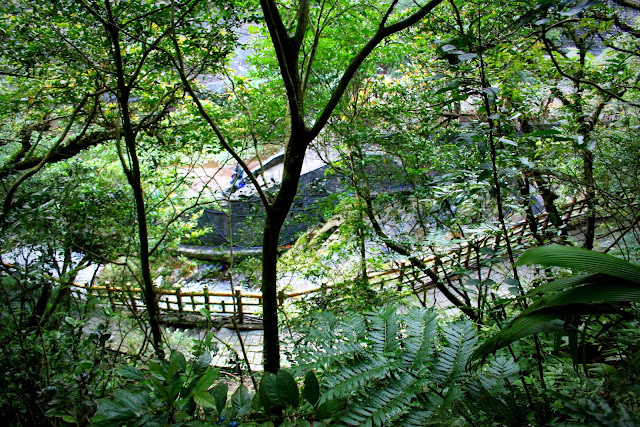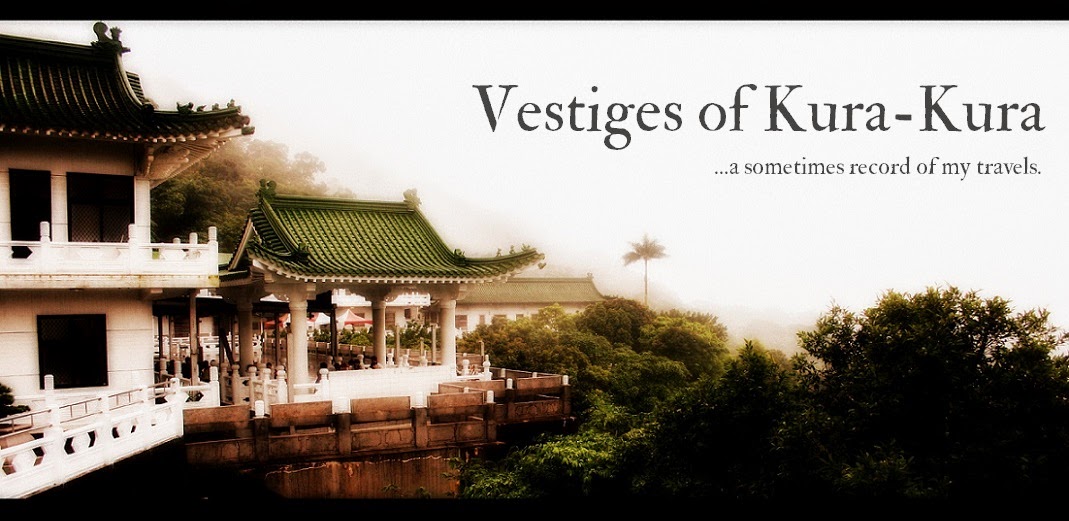I haven't gone hiking yet this month as I've been behind in my Mandarin studies and my kindergarten class has been passing a cold back and forth for a couple weeks now. For awhile every time one of them sneezed their hand would be covered in snot, and though I finally got them all in the habit of asking for permission to get a tissue (mostly to get them speaking more English), I've since had to teach them that if their hand is dripping in goo they don't have to ask first. Rewarding participation with high-fives is too contagious so I've switched back over to "pounding it," also teaching them to pretend to miss hitting each other's high-fives, all as covert ways to decrease the spreading of germs. Nevertheless, I've been coughing up phlegm balls for two weeks now and some days my voice is on the verge of going out.
The Pingxi Rail Line, east of Taipei, has a plethora of trails that I often use as a backup when I'm too lazy to investigate other more obscure options. Saturday was one such day, as I was deciding around one in the morning after a busy Friday where to go. From my abode it takes a good two hours by train to get there. Unusual for Taipei there was a zero percent chance of rain and the new fall weather was making it look like an ideal day for a hike. I took a local train from Banqiao to Badu, then hopped on the single-track Pingxi Line to the terminal stop, Jingtong. This line, formerly used for coal transport, remains open for tourist purposes as many of the old coal mining towns in northern Taiwan have been converted into tourist destinations selling various snack foods and tchotchkes.
 |
| Jingtong Station |
 |
| wishes written on bamboo |
 |
| Jingtong |
 |
| Jingtong |
Heading back towards Pingxi station by foot, following the tracks, it was a short walk through some of the town toward the trail up to Stone Bamboo Shoot Peak.
 |
| walking along the Pingxi tracks |
 |
| Jingtong |
 |
| Jingtong |
Much of the ascent consisted of stone steps, but after I got a bit lost on my last hike, I wasn't feeling as bothered by them as I might have otherwise. As I neared the peak though, the staircase ended and soon enough I was using fixed ropes and footholds to climb my way up some of the rougher terrain. The views along the way were mostly obscured by trees, and I missed the one lookout point mentioned in my guidebook because I got mentally distracted.
 |
| start of the trail to Stone Bamboo Shoot Peak |
 |
| end of the stairs and approaching the peak |
 |
| more challenging ground up to the peak |
 |
| a small overhang |
At the top there was a rock shaped like a small chair, along with a small, rather weathered flag of Taiwan. I anticipated having a leisurely lunch there since the weather was so nice, but there were also a number of brown paper wasps sharing the spot, and I yelped every time one got too near for comfort. I debated heading back down but an older Taiwanese couple soon approached so I stuck around, noshing, having not finished taking photos before they arrived.
 |
| a seat at the top, Stone Bamboo Shoot Peak |
 |
| Stone Bamboo Shoot Peak |
Heading down was a little tricky as some of the vertical parts were simple to climb up, but I had to take a moment to find the right footing to get down. Further from the top, the path got much easier and scenic, soon reconnecting with another set of stairs down to the bottom, where it also connected with the start of the trail to the next peak, Shulang.
 |
| descending, Stone Bamboo Shoot trail |
 |
| descending, Stone Bamboo Shoot trail |
The trail up to Shulang Peak was not so long ago destroyed by the construction a set of stone stairs leading all the way to the top, which makes it a very dull, tedious climb, and I found it especially tiring for some reason. Perhaps it was a combination of lack of sleep, food, and the utter repetition in footwork. It took about thirty minutes of non-stop steps to reach the top, where I was able to see Stone Bamboo Shoot Peak (the peak I just climbed), the Pingxi crags, and surprisingly enough all the way to Taipei with Taipei 101, now fifth tallest building in the world, visible in the distance.
 |
| the dull stone staircase that is Shulang Peak trail |
 |
| almost at the summit |
 |
| view of Pingxi from Shulang Peak |
 |
| view of Stone Bamboo Shoot Peak from Shulang Peak |
 |
| view of Taipei 101 all the way from Shulang |
Near the top was a friendly group of botany hobbyists, the only other people I'd see on Shulang. They, being more mixed in age and ability, went back down the stairs while I took the barely noticeable path to the left that was rather narrow, overgrown, and steep at first but opened up a bit later on. It, however, remained extremely slippery and narrow the whole way down, and I had to tread more carefully than usual, as most of the rocks were covered in an incredibly slippery green moss and the blanketing of fallen leaves on the trail was only slightly less slippery. Luckily a number of tree limbs were perfectly placed to assist my stepping, to the point where my arms were actually a little sore the next day from bracing my weight so often. Often the path would run right along a steep vertical drop down, so that if I did slip I'd surely fall quite a ways and be stuck in utter wilderness (or dead). I took my time on these parts and didn't fixate on what was, or wasn't, below. There was no one in sight the entire way, and I spent most of the hike down in wonder of the scenery and happily singing aloud to the Twin Shadows album I recently acquired.
 |
| descending Shulang Peak trail |
 |
| the rope is more protection against vertigo as to the left its a straight shot down |
 |
| descending Shulang Peak trail |
 |
| slippery green moss-covered rocks |
After maybe forty minutes of careful footwork, I trampled my way out of the woods and reached the small town of Yikeng, only about a fifteen minute walk away from Jingtong, where I started. As little as an hour outside of Taipei's city limits Taiwan becomes a much quieter place, where dwellings and ways of living look like they haven't changed in decades. Arriving back at the train station, I saw that the next train wouldn't be arriving for almost another hour so I walked around a bit more, bought a paper bowl of stinky tofu in a sweet sauce, topped with pickled cabbage, and sat on the ledge of the platform waiting for the train. It arrived after only twenty minutes, and being the first/last stop I was able to get a seat and nap for thirty minutes before its departure back to Badu.
 |
| approaching the town of Yikeng |
 |
| Yikeng |
 |
| Yikeng |
 |
| Yikeng |
 |
| Yikeng |
 |
| walking back to Jingtong, Yikeng |



















